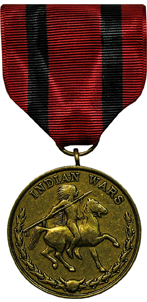
Indian Campaign Medal

Awarded to U.S. Army personnel having participated in military actions against Native American Indians between the years of 1790 and 1891. The United States Department of the Army declared the following fourteen campaigns as credible service to the Indian Campaign Medal: Miami Campaign, part of the Northwest Indian War (January, 1790–August, 1795); Tippecanoe Campaign, part of Tecumseh's War (September 21–November 18, 1811); Creek Campaigns or Creek War (July 27, 1813–August 9, 1814 and February, 1836–July, 1837); Seminole Campaigns or Seminole Wars (November 20, 1817–October 31, 1818; December 28, 1835–August 14, 1842; and December 15, 1855–May, 1858); Black Hawk Campaign or Black Hawk War (April 26–September, 1832); Comanche Campaign (1867–1875); Modoc Campaign or Modoc War (1872–1873); Apache Campaigns or Apache Wars (1873 and 1885–1886); Little Big Horn Campaign or Black Hills War (1876–1877); Nez Perce Campaign or Nez Perce War (1877); Bannock Campaign or Bannock War (1878); Cheyenne Campaign or Cheyenne War (1878–1879); Ute Campaign or Ute War (September, 1879–November, 1880); Pine Ridge Campaign (November, 1890–January, 1891). The Indian Campaign Medal was issued as a one-time decoration only and there were no devices or service stars authorized for those who had participated in multiple actions. The only attachment authorized to the medal was the silver citation star, awarded for meritorious or heroic conduct. The silver citation star was the predecessor of the Silver Star and was awarded to eleven soldiers between 1865 and 1891. In the mid-20th century, the Army declared the Indian Campaign Medal obsolete and began an effort, under pressure, to collect and destroy original and reproduced Indian Campaign Medals. This was due in large part to the notion that the Indian Campaign Medal represented an effort to subjugate a culture and its people. In the modern age, the Indian Campaign Medal is one of the most difficult antique decorations to locate. The award was created in 1905.